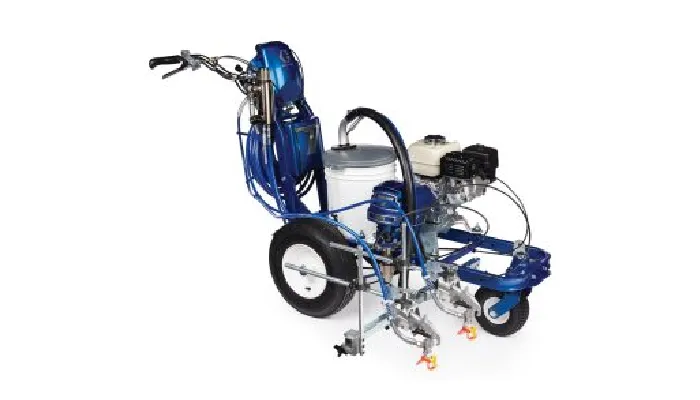
5 Things to Know Before Buying a Line Painting Machine
Before diving into purchasing a line painting machine, there are a few key things to consider that can really make a difference. First, assess the size of your projects: larger jobs need more powerful machines while smaller ones may only require entry-level equipment. Next, think about paint compatibility; not every machine works with all types of paint. Features matter too, look for adjustable line widths and ergonomic designs to simplify your work. Durability is essential, so choose models made from high-quality materials to ensure they last through heavy use. Finally, don’t forget accessories that can enhance performance and overall productivity in your striping tasks.
1. Project Size and Machine Compatibility
Understanding your project size is crucial when selecting a line painting machines. If you’re working on extensive areas, like large parking lots, you will need a more robust machine that can handle high productivity. Smaller machines might be adequate for minor tasks, but they can fall short when it comes to efficiency on larger projects. Consider how often you’ll be dealing with big jobs versus small ones, as this will influence your choice significantly.
Another factor to weigh is your budget against the machine’s size and capabilities. Larger machines usually cost more, but they also come with a higher paint capacity, allowing you to work longer without stopping for refills. This can be a game-changer for maintaining workflow on big jobs.
Additionally, think about the terrain where you’ll be working. Some machines are better suited for uneven surfaces, which can save you time and hassle. User reviews can provide valuable insight into how different models perform across various project sizes, helping you make a more informed decision.
Look for machines with adjustable features that allow you to switch between different project scales. Quick changeovers for various types of jobs can enhance your efficiency. Also, keep in mind that the weight of the machine affects its maneuverability and transport, which is particularly important if you’re moving between job sites.
If you’re worried about the cost of a larger machine for occasional big jobs, consider rental options. Renting can be a cost-effective solution that helps you avoid significant upfront expenses while still allowing you to tackle larger projects when needed.
2. Paint Compatibility and Quality
Before purchasing a line painting machine, it’s crucial to consider paint compatibility and quality. First, identify the types of paint you plan to use most often. This could range from standard water-based paints to more specialized solvent-based options. Understanding the differences between these types is essential, as each has unique requirements and performance characteristics.
Examine the machine’s paint pumping system to ensure it can handle your chosen paint types effectively. Some machines are designed specifically for thicker paints, while others may struggle with viscosity, affecting performance. Machines that support specialty paints, like reflective or anti-slip options, can enhance your projects and meet specific client needs.
Additionally, different paints may influence the machine’s maintenance requirements. For instance, using solvent-based paints might necessitate more frequent cleaning to prevent clogs. Look for models that offer adjustable spray patterns, as this feature can optimize performance for various paint types. A consistent pressure output is vital too, as it helps prevent uneven application, ensuring a professional finish.
Finally, consider paint options that simplify cleaning and maintenance. This can save you time and effort in the long run. Also, keep in mind that warranty implications may vary based on the type of paint you use, so it’s wise to review those terms before making a decision.
- Identify the types of paint you will use most frequently.
- Know the difference between water-based and solvent-based paints and their requirements.
- Examine the machine’s paint pumping system for compatibility with your chosen paint.
- Consider how paint viscosity affects machine performance; some machines handle thicker paints better.
- Check if the machine supports specialty paints like reflective or anti-slip options.
- Research how paint compatibility influences the machine’s maintenance needs.
- Look for models with adjustable spray patterns for different paint types.
- Ensure the machine offers consistent pressure to avoid uneven application.
- Explore paint options that are easier to clean and maintain for your machine.
- Understand warranty implications based on the type of paint used.
3. Features and Flexibility of Machines
When looking at line painting machines, consider their features and flexibility. Machines equipped with electronic controls make it easy to adjust settings accurately, ensuring precision for every line. Safety features are also crucial, as they help protect both the operator and the machine during use. Another important aspect is the ability to make quick adjustments for different line widths on the fly. This is particularly useful when switching between tasks, like marking parking spaces or directional arrows, as it helps maintain a professional appearance.
Automatic paint mixing can save you time and ensure consistency in your paint application. Some advanced models even include GPS or laser guidance for precise line placement, which can significantly enhance the quality of your work. Additionally, assess how easy it is to switch between different spray patterns, as this flexibility can improve efficiency across various projects.
Maintenance is another consideration; look for machines with detachable components that simplify cleaning and upkeep. It’s also worth checking if the machine can be upgraded with new features as technology evolves. A variety of nozzle types can further enhance your spraying capabilities, allowing you to tackle different surfaces and paint types with ease. Lastly, don’t overlook the weight and balance of the machine, as a well-balanced unit can improve maneuverability and control, making your job easier.
4. Durability and Maintenance Considerations
When looking at line painting machines, durability and maintenance are key factors to consider. Start by investigating the materials used in the construction of the machine. Quality materials often indicate a longer lifespan. Look for machines that have corrosion-resistant parts, as these can withstand harsh weather and extend the machine’s longevity.
Another crucial aspect is the warranty offered. A solid warranty can provide peace of mind, so check what it covers in terms of durability and parts. Additionally, consider models that allow for easy access to parts, making repairs quicker and less hassle.
Researching the maintenance requirements for different machines is also important. Some may need frequent upkeep, while others are designed to be low maintenance. User reviews can provide insight into real-world experiences with maintenance, helping you gauge how easy it is to keep the machine in good working condition.
Furthermore, assess how easy it is to clean the machine. Proper cleaning is vital to prevent paint buildup, which can negatively affect performance. Lastly, explore the service and support options available for repairs and maintenance. Understanding the long-term costs associated with maintaining various models will help you make a more informed decision.
5. Accessories and Enhancements for Efficiency
Consider the range of essential accessories that can elevate your line striping projects. For instance, paint strainers are crucial for maintaining paint quality, ensuring a smooth application without clogs. Additionally, bead dispensers are invaluable for adding reflective markings to your lines, enhancing visibility and safety. Check the compatibility of these dispensers with your machine to ensure seamless integration.
Layout tools can also assist in planning and executing jobs more effectively, helping you achieve precise line placements. If you’re interested in stenciling, look for stencils that are easy to apply with your machine, as this can save time and improve the professionalism of your work. Furthermore, having a selection of additional spray nozzles allows you to create different line widths and patterns, giving you versatility for various projects.
Staying organized is essential, so consider storage solutions for your accessories to keep everything in one place. Also, research aftermarket accessories that may enhance your machine’s functionality. Investing in transport options can make moving your equipment between job sites easier, saving you time and effort. Finally, explore software solutions that can help you manage your projects more effectively, streamlining your workflow and enhancing overall productivity.
Frequently Asked Questions
What should I consider when choosing the type of line painting machine?
You should think about the type of projects you’ll be doing, whether you need a machine for large areas or smaller spaces, and the kind of paint you plan to use.
How important is the machine’s weight and portability?
The weight and portability matter a lot, especially if you’ll be moving the machine around frequently or working in different locations.
What maintenance do line painting machines typically require?
Regular maintenance like cleaning the spray tips, checking hoses for wear, and ensuring the machine is stored properly can help it last longer and work better.
Can I use a line painting machine for different types of paint?
Yes, but you need to check the manufacturer’s recommendations, as some machines work better with specific types of paint.
Are there specific features that make a line painting machine easier to use?
Look for features like adjustable spray widths, user-friendly controls, and easy-to-clean designs to improve convenience during use.
TL;DR Before purchasing a line painting machine, consider these five essential factors: 1) Project size and machine compatibility to ensure efficiency; 2) Paint compatibility to match specific paint types for quality results; 3) Features like adjustable line widths and user-friendly designs for flexibility; 4) Durability and maintenance needs for long-lasting performance; and 5) Relevant accessories to enhance your capabilities. Taking these aspects into account will help you make an informed decision and improve your work quality.



